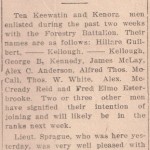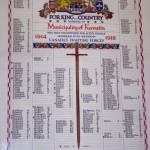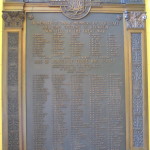

| Personal Details | |
| Date of Birth | May 30, 1886 |
| Place of Birth | Maybole, Ayrshire |
| Country | Scotland |
| Marital Status | Married |
| Next of Kin | Mrs. Mary Kennedy, Keewatin, Ontario |
| Trade / Calling | millwright |
| Religion | Presbyterian |
| Service Details | |
| Regimental Number | 1038021 |
| Service Record | Link to Service Record |
| Battalion | 238th Battalion |
| Force | Canadian Expeditionary Force |
| Branch | Canadian Infantry |
| Enlisted / Conscripted | Enlisted |
| Address at Enlistment | Keewatin, Ontario |
| Date of Enlistment | August 18, 1916 |
| Age at Enlistment | 30 |
| Theatre of Service | Europe |
| Prisoner of War | No |
| Survived War | Yes |
| Death Details | |
| Date of Death | January 16, 1955 |
| Age at Death | 68 |
Kennedy, George Brown
George Brown Kennedy was born on 30 May 1886 in Maybole, Ayrshire, Scotland. His parents were Alex Kennedy and Maggie Brown. Siblings included: Annie (1879-1883), Elizabeth (b. 1883), Alexander (b. 1888), Quintin (1890-1955), Janet (b. 1892), Margaret (1895-1982), and Isabella (b. 1899). Alex Sr. was a shoe maker and at least two of his children, George and Quintin learned his trade.
George immigrated to Canada in June of 1907 and made his way to Keewatin, Ontario. Five months later, on 15 November 1907 he married Mary Fisher who had also been born in Maybole. George found work as a packer at the flour mill in Keewatin. Son, Alex Kennedy was born in May 1908. The 1911 Canadian Census shows the family living on Nelson Street in Keewatin. The 1921 Census shows four more children in the family: Elizabeth Armour (1912-2001), Margaret (Peggy) (b. 1913), Mary Fisher (b. 1915), George (b. 1916-1977).
On 18 August 1916 George enlisted with the 238th Battalion in Kenora, Ontario. A month later he arrived in England and became part of the Canadian Forestry Corps. The Canadian Forestry Corps provided lumber for the Allied war effort by cutting and preparing timber in the United Kingdom and on the continent of Europe. Forestry units also cleared terrain for the construction of installations such as airfields and runways, prepared railway ties, as well as lumber for the creation of barracks, road surfaces, ammunition crates, and trench construction. George was sent to Scotland and on 01 May 1917 was on strength to Company 10 CFC in Edinburgh. He injured his left knee and was transferred to the 3rd Reserve Battalion. In October 1918 George was transferred to the 4th Battalion and sent to France. He served until his return to England in March of 1919. George was struck off strength to Canada on 29 April 1919. He received his official discharge due to demobilization on 09 May 1919 in Toronto.
George returned to his family, his job at the flour mill and Keewatin. Another son, Graham, was born. By 1935 George was a foreman at the flour mill. He retired in 1954.
In July 1954 George and his wife, Mary, traveled to Scotland to visit family. Prior to their planned return in September, George was taken ill. Although his later obituary stated that he died in Maybole, George died on 16 January 1955 in the Western Infirmary in Glasgow. Mary later died in 1968 and is buried in the Lake of the Woods Cemetery in Kenora.
George’s brother, Quintin, also served in WW1, enlisting with the 63rd Battalion in Medicine Hat in 1915.










